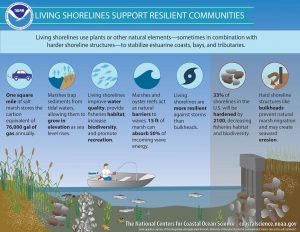Building Living Shorelines
By TH!NK by IBI
Date
November 20, 2017With climate change and rising sea levels, cities are making plans for coastal resilience. A key component of these plans looks at how to deal with higher water at our shorelines, both during major tidal events like hurricanes and, if predictions are correct, year-round. Sea-side cities have traditionally built hard walls around their coasts to protect against flooding, such as in Vancouver, Miami, or New York’s Battery Park. But is there a better approach? Can we do better than building higher walls? Those that study coastal resilience say yes; we should learn to build our shorelines in ways that mimic natural wetlands. These natural shorelines absorb more wave energy and protect against erosion far better than a traditional hard edge. As described by the National Ocean and Atmospheric Administration, there are additional sustainability benefits to these “living” designs:
“Living shorelines are a green infrastructure technique using native vegetation alone or in combination with offshore sills to stabilize the shoreline. Living shorelines provide a natural alternative to ‘hard’ shoreline stabilization methods like stone sills or bulkheads, and provide numerous benefits including nutrient pollution remediation, essential fish habitat provision, and buffering of shoreline from waves and storms. Living shorelines are known to store carbon (known as carbon sequestration), which keeps carbon out of the atmosphere. Continued use of this approach to coastal resilience will result in increased carbon sequestration and storage, potentially mitigating the effects of climate change.”
Softer shorelines are also less expensive to construct than their traditional counterparts, with longer lifespans. According to a post on “Great Lakes Echo“,
“At its best, the technique is half the cost of hard shoreline techniques. Concrete or steel sheet piling costs about $2,000 per linear foot … Soft techniques could cost as little as $1,000 per linear foot. All depends on the project’s specific needs and materials, however. While hard design structures often have a limited life, soft engineering produces living shorelines that can repair themselves.”
How can we incorporate these softer designs into our oceanside projects? These designs work best in places without turbulent tidal water; are there additional, related designs we should be exploring for areas with high tides? Living shorelines are a huge opportunity not just for coastal areas, but also on floodplains. What can we adapt from these strategies to places with increasingly disruptive floods?
Photo by Jimmy Conover on Unsplash








